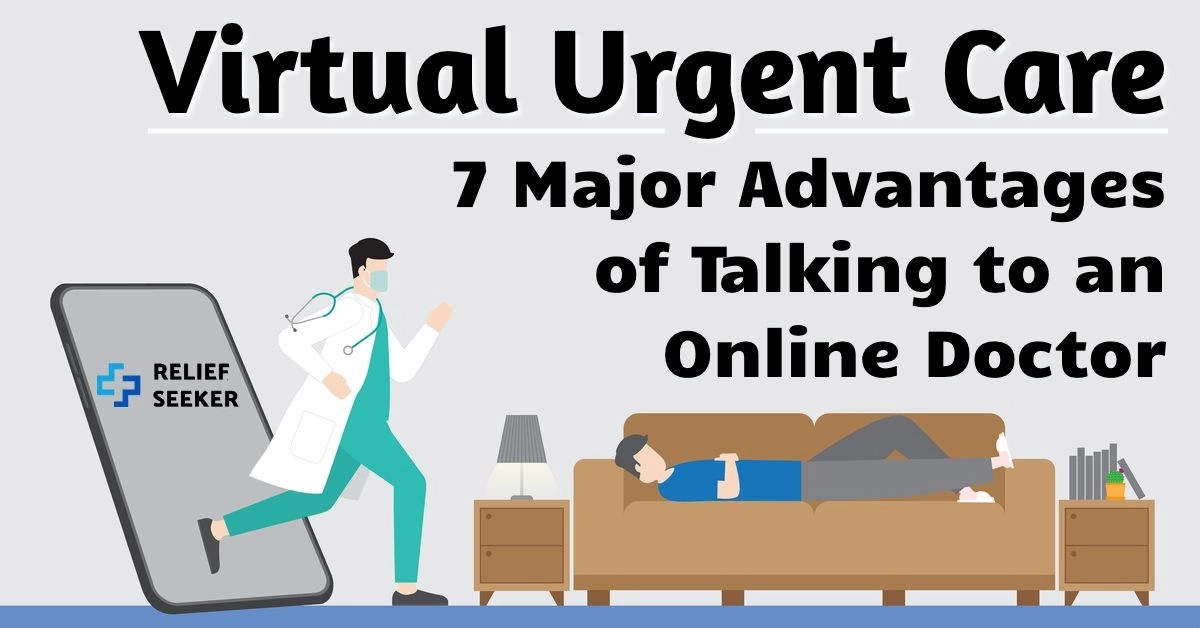Telehealth (otherwise known as virtual visits) benefits both patients and providers.
This is not only true for primary care, as many specialists have embraced virtual care for telemedicine and urgent care. Virtual urgent care increases the quality of on-demand medical services while lowering costs.
Talk to a doctor online via your smartphone, tablet, or computer to get on-demand diagnosis and treatment — all in the comfort and safety of your home.
Online urgent care patients have access to a wider variety of doctors, greater convenience, and lower costs. Discover the seven major advantages of virtual urgent care through online urgent care providers.
How does virtual urgent care work?
Virtual urgent care is best for treating minor medical conditions. Get diagnosed and treated for common, non-emergency medical conditions from the comfort of your own home. Talk to a doctor online, get prescriptions mailed directly to your local pharmacy, and make follow-up appointments.
One study shows the average number of telehealth visits per patient is 1.3 visits per year. The most common virtual diagnoses made are sinusitis, cold, flu, whooping cough, and urinary tract infections. The initial telehealth visit resolves patient issues an average of 83% of the time.
Virtual urgent care is good for:
Abdominal pain
Bronchitis
Common Cold
Fever
Infection
Joint aches and pain
Migraine/headache
Nausea and vomiting
Pinkeye
Rash
Respiratory infection
Seasonal flu
Skin conditions
Sinus problem
Sore throat
Stomach ache
Yeast infection
Other conditions
Most online urgent care facilities cannot treat serious conditions, and you may want to head to an in-person provider for such health issues that may require hands-on exams, blood work, lab tests, or x-rays. For medical emergencies, call 911 or visit your nearest emergency care location.
What to expect during a virtual visit
Virtual care utilizes the same technical devices you use every day — your phone, tablet, or computer.
Most providers will prefer to set up a video chat to assess your symptoms. In some cases, a phone call or chat function may be offered depending on the nature of your request.
To set up your appointment, your provider may send a link to their online web portal. They may also ask you to download an app to facilitate your appointment. You will likely need to complete a brief medical history questionnaire before the appointment.
During your virtual consultation, you will:
Access the video, phone, or chat function to connect with your provider
Discuss your concerns and symptoms
Receive a diagnosis and guidance on treatment
If you need medication, your doctor will write you a prescription and send it to your local pharmacy.
7 Advantages of Virtual Urgent Care
Virtual urgent care offers seemingly endless benefits; yet, there are seven main benefits to online urgent care that rise to the top, including better access to doctors, fewer commutes, lower costs, better doctor engagement, and streamlined patient privacy.
Better Access to More Doctors
Urgent care clinics emerged from a demand for same-day non-emergency services. Today, urgent care has become a primary source of care for many who don’t want to wait to schedule with their physician.
You are no longer limited by proximity. Virtual urgent care allows patients to access doctors anywhere nationwide, 24/7. This means patients in one provider setting can reach a specialist in a distant region. This is especially important for remote, lower-income populations so they can get access to the quality care they need. Virtual urgent care is also being used to reroute unnecessary ER visits.
Medical specialists that offer virtual services:
Allergists
Cardiologists
Gastroenterologists
Gynecologists
Immunologists
Nephrologists
Obstetricians
Oncologists
Ophthalmologists
Psychiatrists
Radiologists
Talk to a Doctor Online
Virtual urgent care allows you to access quality healthcare from anywhere. You can talk to a doctor online from the comfort of your own home. No need to take time off work. No need to lose time traveling to doctor appointments. No more waiting in patient rooms.
Virtual appointments are scheduled quickly by phone or online and can be completed faster. According to the American Journal of Managed Care, the average total time associated with medical visits was 121 minutes. The study averaged 37 minutes for travel time and 84 minutes in the clinic. But only 20 minutes of this time spent is reported face-to-face with the physician.
So virtual appointments shave off an average of 100 minutes of your time. Often appointments are scheduled for 30 min depending on the nature of the concern. But talking to your doctor online can take only 20 minutes or less while achieving the same quality results.
No More Transportation Barriers
According to the Health Research and Educational Trust, 3.6 million Americans cannot access medical care due to transportation issues. This includes not having access to a vehicle, long distances, and lengthy times to reach needed care locations, transportation costs, and inadequate infrastructure. This can be especially challenging for rural, urban, and lower-income communities.
Telehealth has not only made it more convenient for patients to enjoy care at home, but it has provided care to people with mobility limitations and those who don’t have easy access to local clinics.
Lower Costs, More Affordable
Telemedicine is more efficient and tends to be less expensive than in-person appointments. Costs vary depending on the services needed and your health insurance. According to a Red Quill Consulting Inc study, the average estimated cost of telehealth is $40 to $50 per visit compared to $136 to $176 in-person. Not to mention the expenses saved for travel and parking.
Researchers found that patients not only save on out-of-pocket cost per medical visit but also a penalty called “opportunity costs.” And this doesn’t account for insurance premiums paid monthly, which are supposed to help cover medical expenses.
Quality of Engagement
Video screen sharing enabled doctors to share patient records and charts during virtual appointments. Developments with health kiosks have enabled doctors to take blood pressure, listen to your heartbeat, and look into your ear with an otoscope plug-in. These advancements improved the quality of service of doctors. Because they better explain the condition and guide procedures by sharing real-time readouts on devices. So patients have more transparency and understanding in the process.
Also, virtual care allows for voice and text messaging securely. This helps the flow of health updates across care teams, improving the overall patient experience.
Better Privacy and Record-Keeping
Telemedicine services must follow HIPAA compliance. This means your medical information remains safe and secure when talking to a doctor online.
Doctors can use cameras in video calls to take relevant photos. Patients can enter information directly on the online portal. This makes it easier for doctors to have updated patient information and compare during follow-up visits.
Safety
Virtual urgent care eliminates child or eldercare issues. Online care reduces the chances of catching illnesses in the waiting room. This makes it much safer for people, especially those with a weakened immune system.
Virtual care became vastly important during the outbreak of the COVID-19 pandemic. Patients were able to continue to get the care they needed without subjecting themselves to more risk.
Frequently Asked Questions
Most patients have a few common questions when it comes to online urgent care, and most questions revolve around insurance practices and online prescriptions.
Is virtual urgent care accepted by insurance and HSA?
Your insurance plan may cover telehealth services. Benefits are available when virtual services are offered through your network provider. Check with your health plan to see if it’s covered for you.
HSA does not cover telemedicine services because of reduced-cost benefits, which disqualifies HSA coverage. But funds in your HSA can be used to cover the copay for virtual services.
Can I get a prescription from virtual urgent care appointments?
Yes, doctors can write prescriptions and prescription refills after an online consultation.
Virtual urgent care is an effective way to interact with your doctor to get the immediate care you need. There were doubts that virtual services could give the same quality of care when telemedicine first became available, but virtual appointments have proven to be more convenient and cost-effective.
NBCI studies show that patients receive the same or better health outcomes from virtual care as those receiving in-person care.
Talk to a Doctor Online: Virtual Urgent Care Providers
Health Sapiens provides affordable and unlimited access to licensed medical doctors and therapists throughout the U.S., 24 hours a day, seven days a week, including holidays. Members have the option to talk to a doctor online or chat with a therapist via their smartphone or computer without having to leave the comfort of their own home.
Med & Beyond is a telehealthcare company that blends high-quality medical care with cutting-edge technology, creating a seamless patient experience. Its services are affordably priced, ensuring everyone can access quality treatments, regardless of income.


